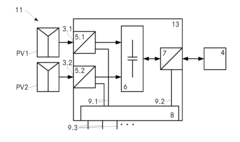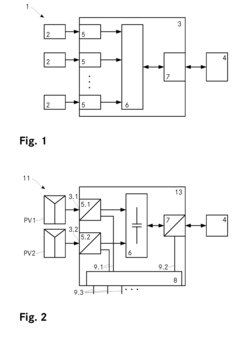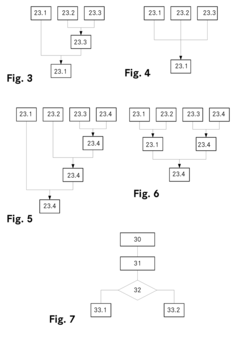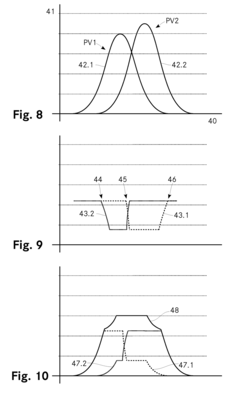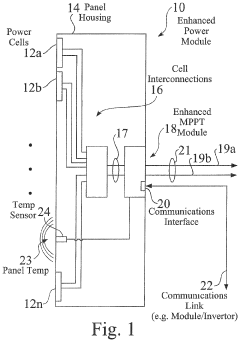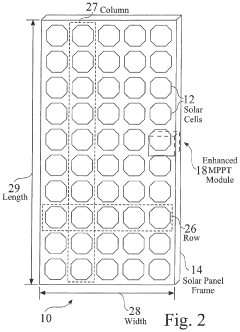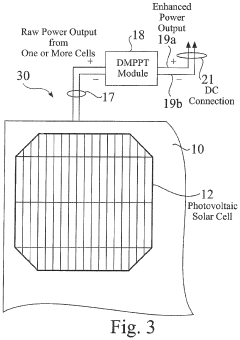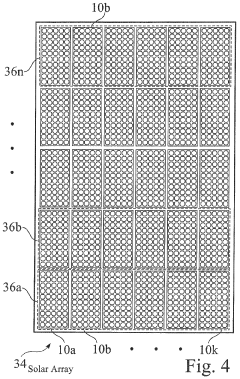Solar Inverter Efficiency: Techniques for Optimization
JUL 17, 20259 MIN READ
Generate Your Research Report Instantly with AI Agent
Patsnap Eureka helps you evaluate technical feasibility & market potential.
Solar Inverter Evolution and Efficiency Goals
Solar inverter technology has undergone significant evolution since its inception in the 1990s. Initially, these devices were primarily focused on converting DC power from solar panels to AC power for grid use. However, as the solar energy industry has grown, the demands on inverters have become increasingly complex and sophisticated.
The early 2000s saw the introduction of string inverters, which allowed for more efficient power conversion from multiple solar panels. This was followed by the development of microinverters in the late 2000s, which optimized power output at the individual panel level. These advancements marked crucial steps in improving overall system efficiency.
In recent years, the focus has shifted towards smart inverters capable of providing grid support functions, such as voltage regulation and reactive power control. This evolution reflects the growing need for solar systems to actively participate in grid stability and management.
The efficiency goals for solar inverters have also evolved significantly. Early inverters typically achieved efficiencies around 90-92%. Today, top-tier inverters boast efficiencies exceeding 98%, with some reaching up to 99%. This improvement, while seemingly small, translates to substantial energy savings over the lifetime of a solar installation.
Current technological goals for solar inverter efficiency include pushing the boundaries of power conversion efficiency even further, with research aimed at surpassing the 99% mark. Additionally, there is a strong focus on improving partial load efficiency, as inverters often operate below their rated capacity due to varying solar conditions.
Another key objective is to enhance the reliability and lifespan of inverters. As critical components in solar energy systems, inverters need to maintain high efficiency over extended periods, often in challenging environmental conditions. This has led to research into advanced thermal management techniques and more durable materials.
The integration of energy storage solutions with solar inverters is also becoming a priority. Hybrid inverters, capable of managing both solar power and battery storage, are gaining prominence. The goal is to optimize the overall system efficiency by seamlessly balancing power generation, storage, and consumption.
Looking ahead, the industry is setting ambitious targets for solar inverter technology. These include achieving ultra-high efficiencies (>99.5%), developing more compact and lightweight designs, and incorporating advanced AI and machine learning algorithms for predictive maintenance and performance optimization. The ultimate aim is to create inverters that not only maximize energy conversion but also contribute to a more resilient and flexible power grid.
The early 2000s saw the introduction of string inverters, which allowed for more efficient power conversion from multiple solar panels. This was followed by the development of microinverters in the late 2000s, which optimized power output at the individual panel level. These advancements marked crucial steps in improving overall system efficiency.
In recent years, the focus has shifted towards smart inverters capable of providing grid support functions, such as voltage regulation and reactive power control. This evolution reflects the growing need for solar systems to actively participate in grid stability and management.
The efficiency goals for solar inverters have also evolved significantly. Early inverters typically achieved efficiencies around 90-92%. Today, top-tier inverters boast efficiencies exceeding 98%, with some reaching up to 99%. This improvement, while seemingly small, translates to substantial energy savings over the lifetime of a solar installation.
Current technological goals for solar inverter efficiency include pushing the boundaries of power conversion efficiency even further, with research aimed at surpassing the 99% mark. Additionally, there is a strong focus on improving partial load efficiency, as inverters often operate below their rated capacity due to varying solar conditions.
Another key objective is to enhance the reliability and lifespan of inverters. As critical components in solar energy systems, inverters need to maintain high efficiency over extended periods, often in challenging environmental conditions. This has led to research into advanced thermal management techniques and more durable materials.
The integration of energy storage solutions with solar inverters is also becoming a priority. Hybrid inverters, capable of managing both solar power and battery storage, are gaining prominence. The goal is to optimize the overall system efficiency by seamlessly balancing power generation, storage, and consumption.
Looking ahead, the industry is setting ambitious targets for solar inverter technology. These include achieving ultra-high efficiencies (>99.5%), developing more compact and lightweight designs, and incorporating advanced AI and machine learning algorithms for predictive maintenance and performance optimization. The ultimate aim is to create inverters that not only maximize energy conversion but also contribute to a more resilient and flexible power grid.
Market Demand for High-Efficiency Solar Inverters
The market demand for high-efficiency solar inverters has been steadily increasing in recent years, driven by the global push towards renewable energy and the growing adoption of solar power systems. As solar energy becomes more mainstream, both residential and commercial consumers are seeking ways to maximize the return on their investment in photovoltaic (PV) systems. This has led to a surge in demand for solar inverters that can convert DC power from solar panels to AC power with minimal losses.
The efficiency of solar inverters plays a crucial role in the overall performance of PV systems. Even small improvements in inverter efficiency can translate to significant gains in energy production over the lifetime of a solar installation. This has created a competitive market landscape where manufacturers are constantly striving to develop and offer inverters with higher efficiency ratings.
In the residential sector, homeowners are increasingly aware of the benefits of high-efficiency inverters. They are looking for solutions that can help them maximize their energy production and reduce their reliance on grid power. This trend is particularly pronounced in regions with high electricity costs or favorable net metering policies, where the financial incentives for optimizing solar energy production are more substantial.
The commercial and utility-scale solar markets are also driving demand for high-efficiency inverters. Large-scale solar projects require inverters that can handle higher power outputs while maintaining optimal efficiency levels. These projects often have stringent performance requirements and ROI targets, making the efficiency of solar inverters a critical factor in system design and component selection.
Geographically, markets with mature solar industries, such as Europe, North America, and parts of Asia, are showing strong demand for high-efficiency inverters. In these regions, consumers and businesses are often willing to pay a premium for inverters that offer superior performance and long-term energy savings. Emerging solar markets are also beginning to recognize the importance of inverter efficiency as they seek to maximize the output of their growing solar installations.
The increasing focus on smart grids and energy management systems is further fueling the demand for advanced inverters. Consumers and utilities alike are looking for inverters that not only offer high efficiency but also provide features such as remote monitoring, power quality improvement, and grid support functions. This trend is expected to continue as power grids become more decentralized and reliant on distributed energy resources.
As the solar industry continues to mature, the market for high-efficiency inverters is expected to grow significantly. Industry analysts project that the global solar inverter market will expand at a compound annual growth rate of over 15% in the coming years, with high-efficiency models capturing an increasing share of this growth. This robust market demand is driving ongoing research and development efforts to push the boundaries of inverter efficiency and functionality.
The efficiency of solar inverters plays a crucial role in the overall performance of PV systems. Even small improvements in inverter efficiency can translate to significant gains in energy production over the lifetime of a solar installation. This has created a competitive market landscape where manufacturers are constantly striving to develop and offer inverters with higher efficiency ratings.
In the residential sector, homeowners are increasingly aware of the benefits of high-efficiency inverters. They are looking for solutions that can help them maximize their energy production and reduce their reliance on grid power. This trend is particularly pronounced in regions with high electricity costs or favorable net metering policies, where the financial incentives for optimizing solar energy production are more substantial.
The commercial and utility-scale solar markets are also driving demand for high-efficiency inverters. Large-scale solar projects require inverters that can handle higher power outputs while maintaining optimal efficiency levels. These projects often have stringent performance requirements and ROI targets, making the efficiency of solar inverters a critical factor in system design and component selection.
Geographically, markets with mature solar industries, such as Europe, North America, and parts of Asia, are showing strong demand for high-efficiency inverters. In these regions, consumers and businesses are often willing to pay a premium for inverters that offer superior performance and long-term energy savings. Emerging solar markets are also beginning to recognize the importance of inverter efficiency as they seek to maximize the output of their growing solar installations.
The increasing focus on smart grids and energy management systems is further fueling the demand for advanced inverters. Consumers and utilities alike are looking for inverters that not only offer high efficiency but also provide features such as remote monitoring, power quality improvement, and grid support functions. This trend is expected to continue as power grids become more decentralized and reliant on distributed energy resources.
As the solar industry continues to mature, the market for high-efficiency inverters is expected to grow significantly. Industry analysts project that the global solar inverter market will expand at a compound annual growth rate of over 15% in the coming years, with high-efficiency models capturing an increasing share of this growth. This robust market demand is driving ongoing research and development efforts to push the boundaries of inverter efficiency and functionality.
Current Efficiency Challenges in Solar Inverter Technology
Solar inverter efficiency remains a critical challenge in the renewable energy sector, with current technologies facing several limitations. One of the primary issues is power loss during the conversion process from DC to AC. Despite advancements in semiconductor technology, inverters still experience significant energy losses, particularly under partial load conditions. This inefficiency not only reduces the overall system output but also impacts the economic viability of solar installations.
Thermal management presents another substantial challenge. As inverters process high amounts of power, they generate considerable heat. Inadequate cooling mechanisms can lead to decreased performance and shortened lifespan of components. Current cooling solutions often add complexity and cost to the system, creating a trade-off between efficiency and practicality.
The variability of solar input poses a unique challenge for inverter efficiency. Rapid changes in irradiance due to cloud cover or time of day require inverters to operate efficiently across a wide range of input conditions. Many existing inverters struggle to maintain high efficiency levels during these fluctuations, resulting in suboptimal energy harvesting.
Grid integration issues further complicate the efficiency equation. Inverters must comply with increasingly stringent grid codes and power quality requirements. Meeting these standards often involves additional circuitry and control mechanisms, which can introduce new sources of power loss and reduce overall system efficiency.
The size and weight of inverters also present challenges, particularly for residential and small commercial applications. While more efficient designs often require larger components, there is a constant push for more compact and lightweight solutions. This creates a complex balancing act between efficiency, size, and cost.
Reliability and longevity are closely tied to efficiency concerns. Components stressed by inefficient operation tend to fail more quickly, leading to increased maintenance costs and system downtime. Improving long-term reliability without sacrificing efficiency remains a significant challenge for inverter manufacturers.
Lastly, the cost-efficiency trade-off continues to be a major hurdle. While more advanced and efficient inverter designs are technically feasible, they often come with higher upfront costs. Striking the right balance between improved efficiency and economic viability is crucial for widespread adoption of solar technology.
Thermal management presents another substantial challenge. As inverters process high amounts of power, they generate considerable heat. Inadequate cooling mechanisms can lead to decreased performance and shortened lifespan of components. Current cooling solutions often add complexity and cost to the system, creating a trade-off between efficiency and practicality.
The variability of solar input poses a unique challenge for inverter efficiency. Rapid changes in irradiance due to cloud cover or time of day require inverters to operate efficiently across a wide range of input conditions. Many existing inverters struggle to maintain high efficiency levels during these fluctuations, resulting in suboptimal energy harvesting.
Grid integration issues further complicate the efficiency equation. Inverters must comply with increasingly stringent grid codes and power quality requirements. Meeting these standards often involves additional circuitry and control mechanisms, which can introduce new sources of power loss and reduce overall system efficiency.
The size and weight of inverters also present challenges, particularly for residential and small commercial applications. While more efficient designs often require larger components, there is a constant push for more compact and lightweight solutions. This creates a complex balancing act between efficiency, size, and cost.
Reliability and longevity are closely tied to efficiency concerns. Components stressed by inefficient operation tend to fail more quickly, leading to increased maintenance costs and system downtime. Improving long-term reliability without sacrificing efficiency remains a significant challenge for inverter manufacturers.
Lastly, the cost-efficiency trade-off continues to be a major hurdle. While more advanced and efficient inverter designs are technically feasible, they often come with higher upfront costs. Striking the right balance between improved efficiency and economic viability is crucial for widespread adoption of solar technology.
Existing Efficiency Optimization Techniques
01 Advanced control strategies for solar inverters
Implementing sophisticated control algorithms and strategies to optimize the operation of solar inverters, improving their overall efficiency. These may include maximum power point tracking (MPPT), grid synchronization techniques, and intelligent power management systems.- Advanced control strategies for solar inverters: Implementing sophisticated control algorithms and strategies to optimize the operation of solar inverters, improving their overall efficiency. These strategies may include maximum power point tracking (MPPT), adaptive control systems, and intelligent power management techniques to enhance energy conversion and reduce losses.
- Improved power conversion topologies: Developing and implementing novel power conversion topologies and circuit designs to enhance the efficiency of solar inverters. This may include multi-level inverter architectures, resonant converters, and advanced switching techniques to minimize power losses during the DC to AC conversion process.
- Thermal management and cooling solutions: Incorporating effective thermal management and cooling solutions to maintain optimal operating temperatures for solar inverter components. This can include advanced heat sink designs, liquid cooling systems, or phase-change materials to dissipate heat efficiently and improve overall system performance.
- Integration of wide bandgap semiconductors: Utilizing wide bandgap semiconductor materials such as silicon carbide (SiC) or gallium nitride (GaN) in solar inverter designs. These materials offer superior electrical properties, enabling higher switching frequencies, reduced losses, and improved thermal performance, ultimately leading to increased inverter efficiency.
- Smart grid integration and energy management: Developing solar inverters with advanced communication and control capabilities for seamless integration with smart grids. This includes features such as reactive power control, grid support functions, and energy storage management to optimize overall system efficiency and grid stability.
02 Improved power conversion topologies
Developing and implementing novel power conversion topologies and circuit designs to enhance the efficiency of solar inverters. This may involve the use of advanced semiconductor devices, multi-level inverter configurations, or resonant converter designs.Expand Specific Solutions03 Thermal management and cooling solutions
Incorporating effective thermal management techniques and cooling solutions to reduce power losses and improve the overall efficiency of solar inverters. This may include advanced heat sink designs, liquid cooling systems, or phase change materials for heat dissipation.Expand Specific Solutions04 Integration of energy storage systems
Combining solar inverters with energy storage systems to optimize energy utilization and improve overall system efficiency. This may involve the use of batteries, supercapacitors, or other energy storage technologies to balance power generation and consumption.Expand Specific Solutions05 Smart grid integration and communication
Enhancing solar inverter efficiency through improved integration with smart grid systems and advanced communication protocols. This may include features such as reactive power control, grid support functions, and real-time monitoring and optimization capabilities.Expand Specific Solutions
Key Players in Solar Inverter Manufacturing
The solar inverter efficiency optimization market is in a growth phase, driven by increasing demand for renewable energy solutions. The global market size for solar inverters is projected to expand significantly in the coming years, with a focus on improving efficiency and reducing costs. Technologically, the field is advancing rapidly, with companies like Huawei, SolarEdge, and Enphase leading innovation in smart inverter solutions. These firms are developing advanced power optimization techniques, incorporating AI and IoT capabilities to enhance overall system performance. Established players such as Siemens and ABB are also contributing to technological advancements, while emerging companies like Trina Solar and Delta Electronics are gaining market share with their specialized solutions.
Huawei Technologies Co., Ltd.
Technical Solution: Huawei has made significant strides in solar inverter efficiency through its smart PV solution. The company's string inverters incorporate multi-level topologies and advanced semiconductor materials like silicon carbide (SiC) to reduce switching losses. Huawei's AI-powered MPPT algorithm can increase energy yield by up to 2% compared to traditional methods[4]. Their inverters also feature built-in PID recovery functionality to mitigate potential-induced degradation in solar panels. Huawei's SUN2000 series string inverters can achieve a maximum efficiency of up to 99% and European efficiency of 98.6%[5].
Strengths: High efficiency; smart monitoring and diagnostics; integrated energy storage compatibility. Weaknesses: Reliance on proprietary communication protocols may limit integration flexibility; potential cybersecurity concerns due to connectivity features.
SolarEdge Technologies, Inc.
Technical Solution: SolarEdge has developed a novel DC-optimized inverter system that significantly improves solar inverter efficiency. Their solution combines power optimizers at the module level with a simplified DC-AC inverter. This approach allows for Maximum Power Point Tracking (MPPT) at the individual panel level, mitigating the effects of partial shading and module mismatch. The company's HD-Wave technology utilizes advanced digital processing to synthesize a clean sine wave, reducing the magnitude of heat-dissipating magnetic components by up to 16 times compared to traditional inverters[1]. This results in a lighter and more efficient inverter, achieving up to 99% weighted efficiency[2].
Strengths: Higher energy yield, especially in partial shading conditions; reduced thermal losses; compact and lightweight design. Weaknesses: Higher initial cost compared to traditional string inverters; reliance on proprietary power optimizers.
Core Innovations in Inverter Efficiency Enhancement
Control of a multiple input solar power inverter
PatentActiveUS20180175625A1
Innovation
- A method for controlling a solar power inverter with multiple photovoltaic inputs, involving prioritization of inputs based on characteristics like output voltage, temperature, or run-time, to limit input power and enhance efficiency by calculating and applying set values for DC-DC converters, thereby optimizing power usage and reducing losses.
Distributed maximum power point tracking system, structure and process
PatentActiveUS11967654B2
Innovation
- Distributed Maximum Power Point Tracking (DMPPT) systems and modules are integrated into or retrofitted for each solar panel, providing panel-level control, monitoring, and flexible operation, allowing for enhanced power harvesting and efficiency by boosting voltage and reducing heat dissipation through self-discovery and self-healing functions.
Environmental Impact of Improved Inverter Efficiency
The environmental impact of improved solar inverter efficiency extends far beyond the immediate benefits of increased energy production. As solar power systems become more efficient, they contribute significantly to reducing greenhouse gas emissions and mitigating climate change. Higher efficiency inverters allow for greater energy conversion from solar panels, effectively decreasing the reliance on fossil fuel-based power generation.
This reduction in fossil fuel consumption leads to a substantial decrease in carbon dioxide emissions, as well as other harmful pollutants such as sulfur dioxide and nitrogen oxides. The cumulative effect of widespread adoption of high-efficiency inverters could result in a significant reduction in global carbon footprint, aligning with international climate goals and sustainability initiatives.
Moreover, improved inverter efficiency contributes to the conservation of natural resources. By maximizing the energy output from existing solar installations, there is less need for additional solar panels or expansion of solar farms. This efficiency gain translates to reduced land use requirements, preserving ecosystems and biodiversity that might otherwise be impacted by large-scale solar installations.
The manufacturing process of solar inverters also benefits from efficiency improvements. As inverters become more efficient, fewer raw materials are required per unit of energy produced. This reduction in material consumption leads to decreased environmental impact associated with mining, processing, and transportation of resources used in inverter production.
Additionally, higher efficiency inverters typically have longer lifespans and require less frequent replacements. This durability reduces electronic waste generation, alleviating the environmental burden associated with disposal and recycling of outdated or malfunctioning equipment. The extended lifespan of these components also contributes to the overall sustainability of solar energy systems.
From a broader perspective, the improved efficiency of solar inverters enhances the competitiveness of solar energy compared to traditional energy sources. This increased competitiveness accelerates the transition to renewable energy, potentially leading to faster decommissioning of fossil fuel power plants and their associated environmental impacts.
In urban environments, the adoption of high-efficiency inverters can contribute to reducing the urban heat island effect. By maximizing energy conversion and minimizing waste heat, these inverters help to lower the overall heat output from solar installations in densely populated areas, contributing to improved urban microclimates.
This reduction in fossil fuel consumption leads to a substantial decrease in carbon dioxide emissions, as well as other harmful pollutants such as sulfur dioxide and nitrogen oxides. The cumulative effect of widespread adoption of high-efficiency inverters could result in a significant reduction in global carbon footprint, aligning with international climate goals and sustainability initiatives.
Moreover, improved inverter efficiency contributes to the conservation of natural resources. By maximizing the energy output from existing solar installations, there is less need for additional solar panels or expansion of solar farms. This efficiency gain translates to reduced land use requirements, preserving ecosystems and biodiversity that might otherwise be impacted by large-scale solar installations.
The manufacturing process of solar inverters also benefits from efficiency improvements. As inverters become more efficient, fewer raw materials are required per unit of energy produced. This reduction in material consumption leads to decreased environmental impact associated with mining, processing, and transportation of resources used in inverter production.
Additionally, higher efficiency inverters typically have longer lifespans and require less frequent replacements. This durability reduces electronic waste generation, alleviating the environmental burden associated with disposal and recycling of outdated or malfunctioning equipment. The extended lifespan of these components also contributes to the overall sustainability of solar energy systems.
From a broader perspective, the improved efficiency of solar inverters enhances the competitiveness of solar energy compared to traditional energy sources. This increased competitiveness accelerates the transition to renewable energy, potentially leading to faster decommissioning of fossil fuel power plants and their associated environmental impacts.
In urban environments, the adoption of high-efficiency inverters can contribute to reducing the urban heat island effect. By maximizing energy conversion and minimizing waste heat, these inverters help to lower the overall heat output from solar installations in densely populated areas, contributing to improved urban microclimates.
Grid Integration Challenges for High-Efficiency Inverters
The integration of high-efficiency solar inverters into the electrical grid presents several significant challenges. As the penetration of solar energy increases, the grid must adapt to accommodate the variable and intermittent nature of solar power generation. One primary concern is voltage regulation. High-efficiency inverters can cause rapid voltage fluctuations, particularly in weak grid areas, leading to power quality issues and potential equipment damage.
Frequency stability is another critical challenge. Traditional power systems rely on the inertia of large rotating generators to maintain frequency stability. However, solar inverters lack this inherent inertia, making it difficult to maintain grid frequency within acceptable limits during sudden changes in power output or demand. This issue becomes more pronounced as the proportion of inverter-based generation increases in the grid.
Harmonics and power quality are also significant concerns. While high-efficiency inverters aim to produce a clean sine wave output, they can still introduce harmonics into the grid. These harmonics can cause overheating in transformers and motors, leading to reduced efficiency and shortened equipment lifespan. Advanced filtering techniques and smart inverter functionalities are necessary to mitigate these effects.
Grid protection and fault response pose additional challenges. Traditional protection schemes may not be adequate for bidirectional power flow and the fast-acting nature of inverter-based systems. New protection strategies and equipment are required to ensure grid stability and safety in the presence of high penetrations of solar inverters.
The intermittent nature of solar power also necessitates advanced forecasting and energy management systems. Grid operators must accurately predict solar generation to balance supply and demand effectively. This requires sophisticated weather forecasting tools and real-time monitoring of distributed solar resources.
Lastly, the integration of high-efficiency inverters demands updates to grid codes and standards. Regulations must evolve to address the unique characteristics of inverter-based generation, including requirements for reactive power support, voltage ride-through capabilities, and grid-forming functionalities. These updates are crucial for maintaining grid stability and reliability as the proportion of solar energy in the power mix continues to grow.
Frequency stability is another critical challenge. Traditional power systems rely on the inertia of large rotating generators to maintain frequency stability. However, solar inverters lack this inherent inertia, making it difficult to maintain grid frequency within acceptable limits during sudden changes in power output or demand. This issue becomes more pronounced as the proportion of inverter-based generation increases in the grid.
Harmonics and power quality are also significant concerns. While high-efficiency inverters aim to produce a clean sine wave output, they can still introduce harmonics into the grid. These harmonics can cause overheating in transformers and motors, leading to reduced efficiency and shortened equipment lifespan. Advanced filtering techniques and smart inverter functionalities are necessary to mitigate these effects.
Grid protection and fault response pose additional challenges. Traditional protection schemes may not be adequate for bidirectional power flow and the fast-acting nature of inverter-based systems. New protection strategies and equipment are required to ensure grid stability and safety in the presence of high penetrations of solar inverters.
The intermittent nature of solar power also necessitates advanced forecasting and energy management systems. Grid operators must accurately predict solar generation to balance supply and demand effectively. This requires sophisticated weather forecasting tools and real-time monitoring of distributed solar resources.
Lastly, the integration of high-efficiency inverters demands updates to grid codes and standards. Regulations must evolve to address the unique characteristics of inverter-based generation, including requirements for reactive power support, voltage ride-through capabilities, and grid-forming functionalities. These updates are crucial for maintaining grid stability and reliability as the proportion of solar energy in the power mix continues to grow.
Unlock deeper insights with Patsnap Eureka Quick Research — get a full tech report to explore trends and direct your research. Try now!
Generate Your Research Report Instantly with AI Agent
Supercharge your innovation with Patsnap Eureka AI Agent Platform!
